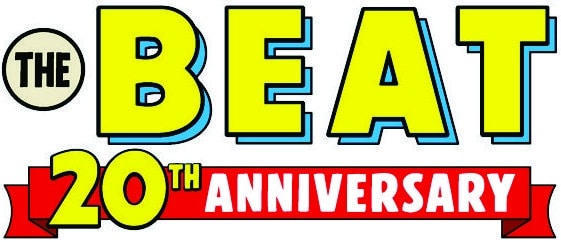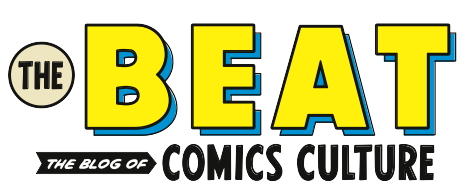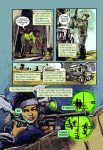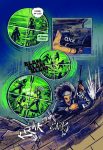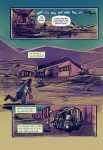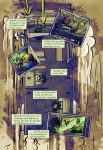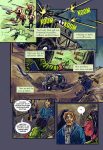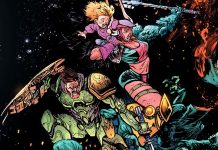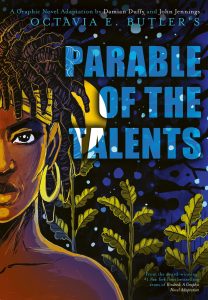
Parable of the Talents
Writers: Octavia E. Butler and Damian Duffy
Illustrators: John Jennings and David Brame
Publisher: Abrams ComicArts
Publication Date: April 2025
As readers, we bring our experiences and worldview to whatever we read. For me, I love comics, and I also love science fiction. I live for the times when these two genres intersect and produce a grand work of art. For the longest time, I’ve avoided reading a lot of Octavia Butler’s work — considered one of the Godmothers of Black Speculative fiction — because I felt I wasn’t ready.
In 2020, for some bizarre reason, I felt like I was ready to read the 1994 New York Times Notable Book of the Year Parable of the Sower during COVID-19. If you aren’t familiar with the Parable duology, this is a world ravaged by systematic injustices and ecological disasters. It’s a dystopian world that hits way too close to home in these days of censorship coupled with political, social, and economic oppression.
The setting starts with Sower in the 2020s and jumps to the near future of 2035 in Butler’s follow-up to Sower, the science fiction novel Parable of the Talents. Talents has now become the third graphic novel by the Hugo Award-winning creative team of Damian Duffy and John Jennings to have been adapted for the publisher, Abrams ComicArts, including the first half of the duology, Parable of the Sower.
Like Sower, Talents is told primarily through the journals of Lauren Oya Olamina, a young woman with the gift of hyper-empathy, also called sharing. In this dystopian setting, this gift can also be a curse. Olamina’s life is upended when her gated community is overrun, with her friends and family murdered, she is forced to flee. Along her travels she finds a new family in other people looking to survive in this brutal world of slavery and rape. In this newfound family and travels, her journaling becomes the foundation for her concept of a new way of life, Earthseed.
The tenants of Earthseed include Change as part of life, but in the creation of Earthseed, Olamina’s ultimate goal is to create a movement that will lead humanity to the stars.
Earthseed: The Book of the Living, verse 54: Choose your leaders
Choose your leaders
with wisdom and forethought.
To be led by a coward
is to be controlled
by all that the coward fears.
To be led by a fool
is to be led
by the opportunists
who control the fool.
To be led by a thief
is to offer up
your most precious treasures
to be stolen.
To be led by a liar
is to ask
to be told lies.
To be led by a tyrant
is to sell yourself
and those you love
into slavery.
To complement Olamina’s narration, we get her stolen daughter, Larkin Olamina aka Asha Vere, who adds to the story with her point of view after their forced separation. Adopted by the Alexanders, a Christian American family fully entrenched in the politics of President Andrew Steele Jarret, a Christian fundamentalist who wants to “Make America Great Again.” Larkin’s life with the Alexanders could be considered privileged, but it is more reminiscent of the reeducation schools that Indigenous people suffered at the hands of the United States.
While the plot thread of Olamina’s search for Larkin and the creation of Earthseed is the cornerstone of the book, for me, Larkin’s journey in finding her way in life as a high-end dreamask content creator and connecting with her uncle (a real piece of work) resonates with me the most. She learns about who her mother is much later in life, but even in finding her, there is a barrier of resentment because of her mother’s calling in creating Earthseed.
This parallel narrative of the horrors of a dystopian society with the programmed haves and repressed have-nots adds a bitter flavor, you can only wonder what their lives would have been like if they were able to stay together.
If you’ve somehow not exposed yourself to Jennings’s artwork, it is a visceral and frenetic style that invokes woodcutting prints but for the digital age. With David Brame credited with layouts, I’m not sure how much of the design work was shared between him and Jennings, as the look of the control collars used to enslave people will remind you of the xenomorphs from the Alien franchise. It’s almost appropriate as the collars transform the captured people into shadows of themselves, a raw and feverish style for a heavy read filled with unnecessary tragedy.
Reviewing the split color pallets gives each narrative a visual voice. Larkin/Asha has a brighter look that fits her futuristic POV, while Olamina’s world is colored with more subdued earthy colors or intense dark swatches to convey the situation. Olamina’s pallet shifts are used when her world shifts, like the destruction of Acorn, her search for Larkin, or the expansion of Earthseed.
And in case you’re not interested in another doom and gloom story warning us about our fate, Talents is more than that, it is an epic sci-fi story, a survival guide, and a spiritual roadmap. The things that Butler wrote about with President Jarret making America great again, the Alaska-Canada War, or his persecution of anyone that is considered other, non-American or LGBTQIA+, under the guise of Christianity in the late ’90s resonate HARD in the era of Felony-47, his cronies, and the co-opting of Reagan’s infamous slogan.
In the late ’90s, Sower and Talents would have been a crystal ball to the future, but today, they are a disturbing reflection of our times. While Duffy and Jennings do a fantastic job interpreting the horror of this recognizable world, they do a better service to the work in relaying Butler’s vision of hope and salvation for humanity.
Parable of the Talents will be released in hardcover and digital formats on April 22, 2025
Read more great reviews from The Beat!
